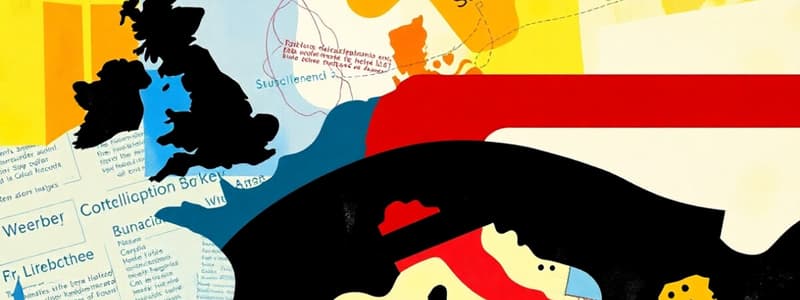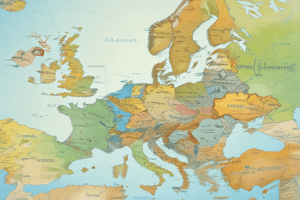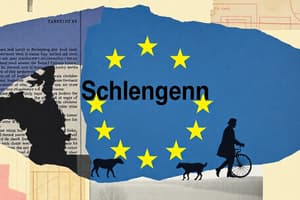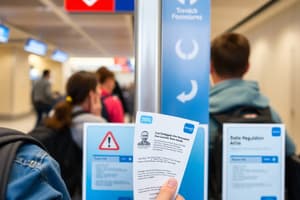Podcast
Questions and Answers
What does Article 21 of the TFEU establish regarding individuals in member states?
What does Article 21 of the TFEU establish regarding individuals in member states?
- It establishes a quota for border crossings.
- It allows free movement between member states. (correct)
- It restricts movement between member states.
- It mandates health checks at internal borders.
Which regulation focuses on the creation of the Visa Information System?
Which regulation focuses on the creation of the Visa Information System?
- Reg 2021/1134
- Reg 2019/1896
- Reg 2017/458
- Reg 767/2008 (correct)
What is defined in Article 2 of the Schengen Border Code?
What is defined in Article 2 of the Schengen Border Code?
- Rights of third-country nationals.
- The procedures for visa applications.
- The distinction between internal and external borders. (correct)
- Conditions for entry into the Schengen area.
Which Treaty integrated the Schengen acquis into EU law?
Which Treaty integrated the Schengen acquis into EU law?
What does Article 22 of the Schengen Border Code state about internal borders?
What does Article 22 of the Schengen Border Code state about internal borders?
Which regulation established the Entry/Exit system for the Schengen area?
Which regulation established the Entry/Exit system for the Schengen area?
What does the term 'Schengen Acquis' refer to?
What does the term 'Schengen Acquis' refer to?
What is the purpose of Article 29 of the Schengen Border Code?
What is the purpose of Article 29 of the Schengen Border Code?
Which criterion ranks highest in determining the responsible member state for an individual's entry into the Schengen area?
Which criterion ranks highest in determining the responsible member state for an individual's entry into the Schengen area?
What does A77 stipulate regarding travel for third-country nationals (TCNs)?
What does A77 stipulate regarding travel for third-country nationals (TCNs)?
Under which article is the mechanism of relocation based on solidarity addressed?
Under which article is the mechanism of relocation based on solidarity addressed?
What is the significance of Council Decisions 2015 regarding member states?
What is the significance of Council Decisions 2015 regarding member states?
Which directive addresses highly qualified employment for TCNs?
Which directive addresses highly qualified employment for TCNs?
What is the primary purpose of the Schengen Information System?
What is the primary purpose of the Schengen Information System?
Which regulation extended the Visa Information System to long stay visas and residence permits?
Which regulation extended the Visa Information System to long stay visas and residence permits?
What significant change does Reg 2024/1358 bring to Eurodac?
What significant change does Reg 2024/1358 bring to Eurodac?
What is the main function of the Entry/Exit System as per Reg 2017/2226?
What is the main function of the Entry/Exit System as per Reg 2017/2226?
What does Reg 2018/1240 establish?
What does Reg 2018/1240 establish?
Which principle allows Member States to carry out checks within their own territory?
Which principle allows Member States to carry out checks within their own territory?
What was a significant reason for the temporary reintroduction of border controls in 2013?
What was a significant reason for the temporary reintroduction of border controls in 2013?
What is the maximum duration for which internal border controls can be reintroduced in foreseeable cases like the Olympics?
What is the maximum duration for which internal border controls can be reintroduced in foreseeable cases like the Olympics?
What is the maximum duration for which a total period can be extended?
What is the maximum duration for which a total period can be extended?
What is required to notify the Commission and Member States before extending a total period?
What is required to notify the Commission and Member States before extending a total period?
What is A28 primarily concerned with?
What is A28 primarily concerned with?
Under what condition can internal controls be recommended according to A29?
Under what condition can internal controls be recommended according to A29?
What event led to the reintroduction of internal controls in France for COP21?
What event led to the reintroduction of internal controls in France for COP21?
What did the ECJ state in April 2022 regarding the extension of A25 use?
What did the ECJ state in April 2022 regarding the extension of A25 use?
Which legal document states that every national of a Member State is a citizen?
Which legal document states that every national of a Member State is a citizen?
What triggered the 2020 reintroduction of internal controls in a disordered way?
What triggered the 2020 reintroduction of internal controls in a disordered way?
Who qualifies as a TCN under the asylum policy?
Who qualifies as a TCN under the asylum policy?
What does Article 33 of the Geneva Convention establish in the context of international protection?
What does Article 33 of the Geneva Convention establish in the context of international protection?
Which directive explains the minimum standards for temporary protection during mass influx?
Which directive explains the minimum standards for temporary protection during mass influx?
Under the new pact, how long are travel documents for asylum beneficiaries valid?
Under the new pact, how long are travel documents for asylum beneficiaries valid?
Which article discusses the right for family members of asylum beneficiaries to claim benefits?
Which article discusses the right for family members of asylum beneficiaries to claim benefits?
What is the minimum duration of residence permits granted to refugees under the Qualification Directive?
What is the minimum duration of residence permits granted to refugees under the Qualification Directive?
What limitation was introduced for asylum applicants regarding their travel documents as per the new pact?
What limitation was introduced for asylum applicants regarding their travel documents as per the new pact?
What defines a stateless person under the discussed policies?
What defines a stateless person under the discussed policies?
What was established by the ECJ in March 2005 regarding student loans?
What was established by the ECJ in March 2005 regarding student loans?
Which of the following statements is true regarding social assistance eligibility?
Which of the following statements is true regarding social assistance eligibility?
What concern did the ECJ express in the November 2014 Dano case?
What concern did the ECJ express in the November 2014 Dano case?
What change did Brexit bring regarding the rights of British nationals?
What change did Brexit bring regarding the rights of British nationals?
What does Article A159 of the Withdrawal Agreement provide for?
What does Article A159 of the Withdrawal Agreement provide for?
What is the purpose of the specialized Committee on citizens’ rights created under the Withdrawal Agreement?
What is the purpose of the specialized Committee on citizens’ rights created under the Withdrawal Agreement?
What must be checked according to the ECJ ruling in July 2021 when refusing access to the social system?
What must be checked according to the ECJ ruling in July 2021 when refusing access to the social system?
Flashcards
Free Movement of Persons within the EU
Free Movement of Persons within the EU
The right of every person within a Member State to move freely between states without border controls.
Schengen Acquis
Schengen Acquis
The Schengen Agreement and the Schengen Convention, along with any acts adopted by the executive committee, form the legal foundation for the free movement of people within the Schengen area.
Schengen Border Code
Schengen Border Code
A legal framework that sets out the rules for internal and external border controls within the Schengen area.
Absence of Controls at Internal Borders
Absence of Controls at Internal Borders
Signup and view all the flashcards
Associated States in Schengen
Associated States in Schengen
Signup and view all the flashcards
Differentiation in Schengen
Differentiation in Schengen
Signup and view all the flashcards
Temporary Reintroduction of Internal Border Controls
Temporary Reintroduction of Internal Border Controls
Signup and view all the flashcards
Maastricht Treaty
Maastricht Treaty
Signup and view all the flashcards
Responsible Member State
Responsible Member State
Signup and view all the flashcards
Criteria for Determining the Responsible MS
Criteria for Determining the Responsible MS
Signup and view all the flashcards
Relocation Mechanism
Relocation Mechanism
Signup and view all the flashcards
EU Immigration Policy
EU Immigration Policy
Signup and view all the flashcards
Schengen Information System (SIS)
Schengen Information System (SIS)
Signup and view all the flashcards
Visa Information System (VIS)
Visa Information System (VIS)
Signup and view all the flashcards
Eurodac
Eurodac
Signup and view all the flashcards
Entry/Exit System
Entry/Exit System
Signup and view all the flashcards
European Travel Information and Authorization System (ETIAS)
European Travel Information and Authorization System (ETIAS)
Signup and view all the flashcards
Frontex
Frontex
Signup and view all the flashcards
Freedom of Movement within Schengen (A22, A23, A24)
Freedom of Movement within Schengen (A22, A23, A24)
Signup and view all the flashcards
Pact on Migration
Pact on Migration
Signup and view all the flashcards
TCNs in a regular situation
TCNs in a regular situation
Signup and view all the flashcards
Asylum Policy Beneficiaries
Asylum Policy Beneficiaries
Signup and view all the flashcards
Non-Refoulement
Non-Refoulement
Signup and view all the flashcards
Temporary Protection
Temporary Protection
Signup and view all the flashcards
Rights of Asylum Beneficiaries
Rights of Asylum Beneficiaries
Signup and view all the flashcards
Long Term Residents Directive
Long Term Residents Directive
Signup and view all the flashcards
Travel Documents for Asylum Applicants
Travel Documents for Asylum Applicants
Signup and view all the flashcards
Right to a student loan in the EU
Right to a student loan in the EU
Signup and view all the flashcards
Maximum Duration of Internal Border Controls
Maximum Duration of Internal Border Controls
Signup and view all the flashcards
Right to minimum subsistence allowance in the EU
Right to minimum subsistence allowance in the EU
Signup and view all the flashcards
What are the 'Exceptional Circumstances' categories for Reintroducing Internal Borders under the Schengen System?
What are the 'Exceptional Circumstances' categories for Reintroducing Internal Borders under the Schengen System?
Signup and view all the flashcards
Right to a tide over allowance in the EU
Right to a tide over allowance in the EU
Signup and view all the flashcards
What is the 'A28' Category for Reintroducing Internal Borders?
What is the 'A28' Category for Reintroducing Internal Borders?
Signup and view all the flashcards
Which Article outlines the General Framework for Internal Border Controls in the Schengen System?
Which Article outlines the General Framework for Internal Border Controls in the Schengen System?
Signup and view all the flashcards
EU Social Assistance criteria
EU Social Assistance criteria
Signup and view all the flashcards
Degree of integration for EU social assistance
Degree of integration for EU social assistance
Signup and view all the flashcards
When are Internal Border Controls Reintroduced under the A29 Category?
When are Internal Border Controls Reintroduced under the A29 Category?
Signup and view all the flashcards
What is the 'A25a' Category Used for Reintroducing Internal Borders?
What is the 'A25a' Category Used for Reintroducing Internal Borders?
Signup and view all the flashcards
Impact of Brexit on EU/UK citizens
Impact of Brexit on EU/UK citizens
Signup and view all the flashcards
EU/UK citizens’ rights under the Withdrawal Agreement
EU/UK citizens’ rights under the Withdrawal Agreement
Signup and view all the flashcards
What did the European Court of Justice (ECJ) rule regarding extending internal borders under A25?
What did the European Court of Justice (ECJ) rule regarding extending internal borders under A25?
Signup and view all the flashcards
Safeguards and remedies for the Withdrawal Agreement
Safeguards and remedies for the Withdrawal Agreement
Signup and view all the flashcards
Who recommends internal border controls and how are other Member States (MS) notified?
Who recommends internal border controls and how are other Member States (MS) notified?
Signup and view all the flashcards
Study Notes
Part 1: The Right to Cross Borders of the Schengen Area
- Every person within a Schengen Member State can move freely between states.
- Schengen Border Code (Regulation 2016/399) details the rules.
- The Schengen Agreement (1985) and Convention (1990) created the Schengen Area.
- Maastricht Treaty and Amsterdam Treaty integrated Schengen into EU law.
- Article 2 defines internal and external borders.
- Article 5 restricts external borders.
- Article 6 sets valid entry conditions.
- Article 8 governs external border controls for people with the right to move.
- Article 21a of the Treaty on the Functioning of the European Union (TFEU) allows restrictions on external borders during emergencies.
- Article 22 prohibits restrictions on internal borders.
- Article 23 allows Member States to conduct checks within their territory.
- Article 24 states there should be no checks at internal borders.
- Article 25 outlines foreseeable cases for internal border controls.
- Article 28 addresses internal border controls for public health reasons.
- Article 29 allows controls in exceptional circumstances putting the Schengen Area at risk.
- Regulation 2017/458 created new databases for checks.
- Regulation 2021/1134 reformed the Visa Information System.
- Regulation 767/2008 established the Visa Information System.
- Regulation 603/2013 created Eurodac (which was repealed by Regulation 2024/1358).
- Regulation 2017/2226 established the Entry/Exit System.
- Regulation 2019/1896 created Frontex.
- Regulation 2018/1240 established the European Travel Information and Authorization System (ETIAS).
- Regulation 2024/1717 amended the Schengen Border Code (SBC).
- Differentiation: The free movement scope varies between states.
Part 2: The Right to Move and Reside Freely in the EU
- Article 20 of the Treaty on the Functioning of the European Union (TFEU) grants EU citizens the right to move and reside freely.
- Article 21 gives the Council the power to issue social security and protection acts related to social security.
- Article 77,78, and 79 of the TFEU deal with the rights of third-country nationals to move and reside freely.
- Directive 2004/38 covers the right of citizens to move and reside freely.
- Article 2 addresses family members.
- Chapter 2 and 3 deal with exit, entry, and residence rights.
- Articles 4, 5, 8, 12, 13, 16, and 24 are specific to the rights themselves.
- Articles 27–29 are the right's limitations.
Part 3: Schengen Acquis and External Borders
- The Schengen Acquis includes Schengen Agreement, Convention, and executive committee decisions.
- Associated states are part of the Schengen Area but not the EU.
- Instrumentalization of migrants occurs when third parties use them to leverage the Schengen Area.
- Schengen cooperation/Agreement/Area/Acquis includes agreements outside the EC framework (1985–1997).
- The Maastricht Treaty created 3 pillars of competence for the EU: integration method, competence devolved to the EU, and Justice and Home Affairs.
- The Amsterdam Treaty addressed the conflict between the Schengen Area and EU third pillar competences.
- Schengen Borders Code 2006 (A62 TEC/A77 TFEU) aims for a coherent text about Schengen.
- The Schengen Area currently encompasses 29 states, with 25 also being EU members.
- Some third-country states are considered part of Schengen due to location, eg Vatican City, Monaco, San Marino, etc.
- Ireland and Cyprus are not part of the Schengen Area.
Part 4: Border Checks & Internal Controls
- Article 5 of the Schengen Border Code (SBC) allows crossing external borders at fixed times.
- Article 5(4) (added in 2024) allows temporary border closures for instrumentalization of migrants.
- Article 21a allows for large-scale public emergency restrictions on border controls (eg, testing, quarantine).
- Controls must be proportionate and non-discriminatory per Directive 2004/38/EC.
- Before 2017, internal checks targeted travel documents (minimum checks).
- After 2017, internal checks involve verification of identity, nationality, and databases.
- Third-country nationals are subjected to thorough checks.
- Schengen Information System databases are expanded for TCNs.
Part 5: Visa Information System and Eurodac Regulation
- Schengen visa data is shared across consulates and border points.
- Visa processing and decisions are recorded in the system.
- Eurodac (Regulation 603/2013) is used mostly for asylum purposes.
- Visa Information System (VIS) and Eurodac records were expanded to cover new cases (2024).
- Smart Border programs introduced new systems (e.g., Entry/Exit System).
- Regulations 2017/2226, 2018/1240, and 2019/1896 established new systems.
- Regulations deal with Visa Information Systems, Entry/Exit Systems, and Frontex.
Part 6: Exceptions and Temporary Controls
- Chapter 2 of the SBC allows temporary restrictions on internal borders for the public good (eg, security, health issues).
- A25 deals with foreseeable cases; A28 deals with internal controls concerning public health.
- A29 outlines cases allowing controls due to exceptional circumstances jeopardizing the Schengen Area's functioning.
- Regulation 2024/1717 amends the cases for introducing internal controls.
Part 7: Rights of EU citizens and TCNs
- EU citizens have the right to move and reside freely within the EU.
- Directive 2004/38 clarifies the rights of EU citizens regarding movement and residence within the EU.
- Rights apply to third-country nationals dependent on EU citizens.
- Rules regulate entry, exit, and residence procedures.
Part 8: EU Charter of Fundamental Rights and Withdrawal Agreement
- The EU Charter of Fundamental Rights enshrines the right of EU citizens to move and reside freely.
- The Agreement on the Withdrawal of the United Kingdom covers citizens' rights and the creation of monitoring bodies to safeguard rights.
- Key aspects of the withdrawal agreement also involve the role of the Court of Justice of the European Union (CJEU).
Part 9: Asylum Policy and Visa Policy
- Asylum policy's Qualification Directive covers refugees and subsidiary protection for specific periods.
- Visa policy's conditions and freedom-of-movement regulations apply to third-country nationals (TCNs).
- These policies concerning immigration are related to Schengen and external borders.
Part 10: Loss of Nationality & Social Assistance
- Losing nationality, though individual cases exist, is less a central policy issue within the text.
- Social assistance, though sometimes relevant under cases, requires an in-depth study under separate headings.
Studying That Suits You
Use AI to generate personalized quizzes and flashcards to suit your learning preferences.




